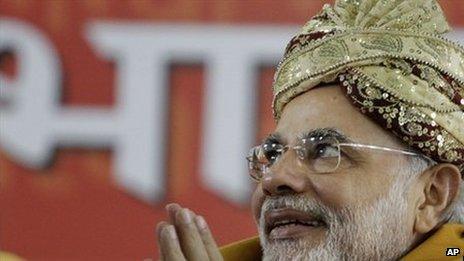Re-making India's economy
- Published

The results coming in from India's general election suggest the ruling Congress Party will be ousted by the BJP.
That would mean India's next prime minister would be Narendra Modi, the man who seeks to remake India's economy.
He has pledged to build manufacturing hubs, cities, hydroelectric power plants, and even bullet trains - essentially an India that is industrialised and urbanised. That has eluded India for some time and is the key to faster economic growth.
Zones
Manufacturing is only 14% of GDP and industrial production, including utilities, is only a quarter of national output. It is essentially unchanged since 1960 which means that India isn't industrialised unlike the other Asian giant, China. Manufacturing is in line with the levels of post-industrialised economies and lags far behind that of other Asian economies that have grown quickly on the back of moving out of agriculture and into production.
I have written before about how India was richer than China in 1990, but lagged behind since. It was only last year that average incomes exceeded $1,000, the level of the poorest countries in the world. China exceeded that threshold a decade ago.
There are many reasons for the disparity, but industrialisation is a significant one. One of the ways China did that was through industrial zones that are geared towards exports.
Protectionism
There's an interesting theory about India's growth. Since independence in 1947, it has grown more slowly than expected. The government seemed to place greater emphasis on social programmes, such as the eradication of basic diseases than on building infrastructure. But that is not the entire picture.
By relying on what economists call import-substitution industrialisation, initially until the 1980s, India's attempt to produce everything at home and be protectionist didn't deliver the industries needed for the economy.
Once it started to open up, especially after two successive IMF rescues in the early 1980s and 1990s - the largest at the time - India didn't attract foreign investment like China did, even though both have more than a billion people.
One of the issues is human capital. Educational enrolment and literacy rates lag that of its Asian neighbours. One of the factors needed to attract foreign investment is a semi-skilled labour force.
Electricity
It's interesting what Modi has done in Gujarat - it's reminiscent of a Chinese Special Economic Zone (SEZ) - a place that is more market-driven than the rest of the country.
SEZs were instrumental in integrating China into global trade that helped propel its growth. In other words, the rest of China may be challenging to operate in, but these industrial zones were quicker to decide on investment and had tailored infrastructure and a migrant labour force to support business.
Importantly, China's SEZs could make decisions locally about investment and setting up factories. In a sense, that's what Modi offered. After two years of debate with West Bengal, Tata decided to build its Nano car plant in Gujarat instead.
It is foreign companies too. Gujarat is one of the top destinations for foreign direct investment in India. Modi also introduced electrification in nearly all 18,000 villages, which is notable in a country where only one-third is electrified.
But, it's not all success. For instance, the attempt to create a financial centre in Gujarat hasn't delivered and the other aspects that will affect India's development such as social spending haven't been as high a priority.
Since last September, the Indian stock market has become a bull market, the Sensex has risen by 21%. It's of course not all attributable to Modi's nomination. The central bank governor took office then, which has led to a so-called [Raghuram] Rajan rally. As the stock indexes rise in anticipation of Modi's victory, I am reminded of what the ex-RBI governor Duvvari Subbarao told me recently. The more important factor in raising India's growth isn't the change in government, but the implementation of reforms.
That is likely to be the true test of a Modi government, as running a country isn't nearly the same thing as running a state.